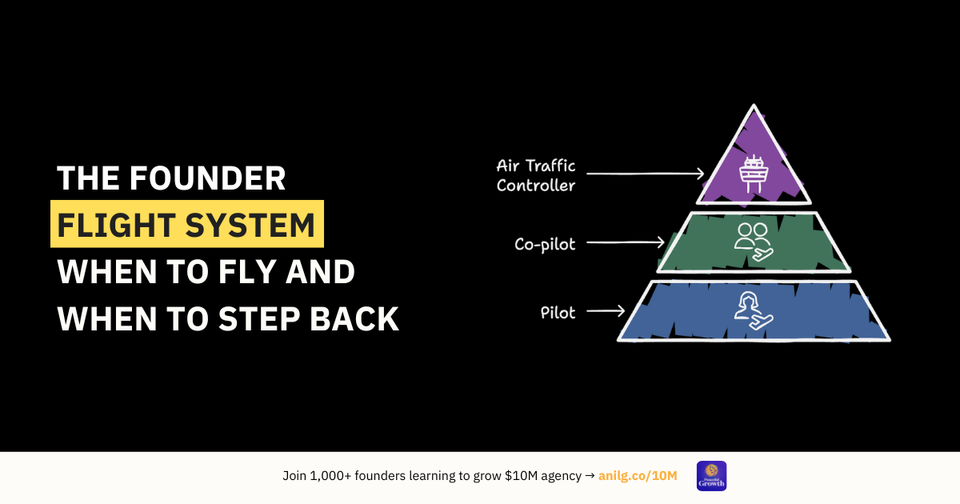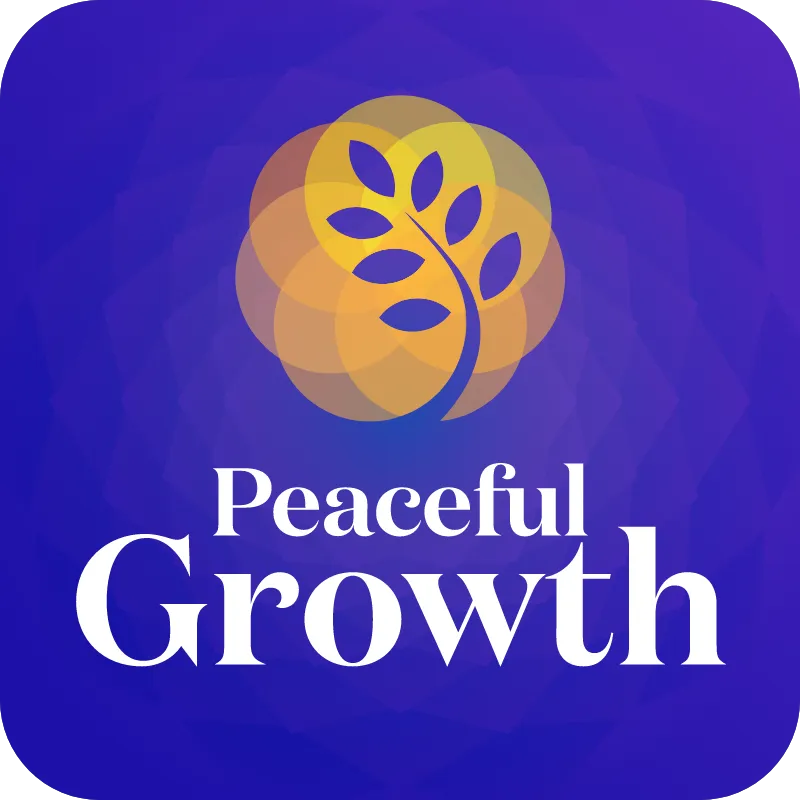How Involved Should a Founder Be in Their Business?

Welcome to Peaceful Growth, where you will find actionable tips to grow your agency to $10M (without working overtime).
Here’s what you can expect in this issue:
- Why common advice like “work ON the business, not IN it” often creates more confusion than clarity
- How to use the “Founder Flight System” to choose the right role—Pilot, Co-pilot, or Air Traffic Controller—based on your team size and stage
- How to build your personal “Founder Dashboard” so you always know the numbers that matter
- Simple rules to stay involved in your business without burning out or bottlenecking growth
The Founder’s Dilemma
In one of my early sessions with a business coach, I was caught off guard.
He asked me a series of simple—but important—questions:
“How do you get leads?”
“How many clients do you have?”
“How many senior engineers are on your team?”
“How do you do X and Y?”
And I didn’t have clear answers.
Instead, I found myself saying things like:
“Oh, my Director of Marketing would know that.”
“My Sales Director tracks that.”
“That’s something our People Ops head handles.”
After 16 years of running this agency, I suddenly realized—I didn’t know the basic operating levers of my business. And that made me feel ashamed.
Shame and Confusion
The voice in my head got loud:
- “I’m losing control.”
- “I don’t know how my business really runs.”
- “Maybe I’ve gotten lazy.”
But my coach didn’t react the way I expected.
He smiled. Then he said something that surprised me:
“This is a good sign. It means your business is growing without being dependent on you.”
He reminded me that investors love businesses where the founder isn’t a bottleneck.
And that most founders he knows wish they could step away more.
It made me feel better—relieved, even.
But also… confused.
The Conflict No One Talks About
Here’s the dilemma:
There’s a flood of advice for founders.
And much of it contradicts itself.
Some say:
“Work on the business, not in it.”
Others argue the opposite.
Keith J. Cunningham, author of The Road Less Stupid, is a vocal advocate for being hands-on:
“No one says they’re on a relationship. You’re in it. The same goes for your business.”
So what’s the answer?
The truth is: both sides are right.
And also wrong—if taken to the extreme.
This is where many founders get stuck. Including me.
You hear stories of Elon Musk running multiple billion-dollar companies, and you wonder if you’re doing too little. Then you read about Bill Gates stepping away and feel like maybe you’re doing too much.
At some point, every founder wrestles with this:
Am I too involved? Or not enough?
The “Founder Flight System” ✈️
I needed a way to make sense of this.
Something practical that I could apply.
That’s how I came up with the Founder Flight System.
I started to imagine my business like an airport.
Planes constantly taking off and landing.
Each plane is a function, a project, or an initiative.
My job as a founder is to help those planes move safely and efficiently.
Sometimes that means I’m the pilot.
Other times, I’m a co-pilot.
And more often now, I’m air traffic controller.
Here’s how each role works:
- Pilot → I’m fully hands-on, running the function day-to-day.
- Co-pilot → I’m supporting someone else, coaching, checking in.
- Air Traffic Controller → I’m setting the direction, aligning priorities, and guiding from above.
The question I ask myself every quarter is simple:
Which planes am I flying? And which ones should I not be?
Practical Guidelines for Founders
Over time, I built a few rules around this model:
- If your team is small (under 10): You’ll likely be piloting most functions.
- If your team is mid-sized (10–25): You should be co-piloting more and slowly handing off planes.
- If your team is 50+: You should mostly be in air traffic control mode, jumping into pilot or co-pilot roles only when needed.
No matter your size, here are the rules I live by as founder:
- Never fly a plane solo. Always have a co-pilot. (Learn more about my delegation template.)
- Don’t pilot a plane for more than 1 year. Train someone. Hand it off.
- Don’t stay a co-pilot for more than 2 quarters. If they’re ready, move out.
- Every 2–3 years, re-enter a plane for a short while. Keep yourself sharp.
- Meet all your pilots monthly. (These are your Directors.)
- Meet your co-pilots biweekly. (Especially where you’re still piloting.)
What Most Founders Get Wrong
Too often, founders stay in the pilot seat too long.
They believe they’re being responsible, but they’re actually creating risk.
Worse, they prevent others on the team from stepping up.
On the flip side, stepping back too far, too early, can be dangerous.
If you haven’t trained pilots and co-pilots, stepping out means the plane might crash.
The trick isn’t to pick a single role and stay there forever.
The trick is to know when to switch.
My Advice to Founders
If you're feeling stuck or uncertain about your involvement…
Don't panic. You’re not alone.
Ask yourself:
- Where am I piloting when I should be co-piloting?
- Where am I watching from the tower when I should be back in the cockpit?
- Who can I train today so I can step out tomorrow?
Then start small. One flight at a time.
Peaceful Growth Begins with Clear Roles
This whole system ties back to something I care deeply about:
Peaceful Growth
Building a business should not feel like chaos every day.
It shouldn’t burn you out or steal your life.
But that only happens if you build systems—not just hustle.
The Founder Flight System gave me peace.
It helped me step in when I was needed, and step out when I wasn’t.
It gave my team clarity.
It gave me energy.
And most importantly—it helped my business grow without growing pain.
Founder's Dashboard
As a founder, you don’t need to know everything.
But you do need to know the few things that matter most.
These 13 metrics give you a crystal-clear view of your business’s health, performance, and risk—without drowning in spreadsheets.
1. Qualified Leads per Month: The number of leads who are a good fit and ready to buy.
2. Monthly Revenue: The pulse of your business—watch it like a hawk.
3. Sales Pipeline $ Value: Total dollar value of all open deals in your sales pipeline.
4. Profit Margin: Revenue is vanity. Profit is sanity.
5. Growth Rate: Your month-over-month or year-over-year revenue growth.
6. Win Rate: The percentage of deals you close vs. total opportunities.
7. Per Employee Cost: The average cost of having one team member (salary + overhead). Helps you understand team efficiency and plan hiring wisely.
8. Average Revenue per Client: How much one client brings in over a year. Useful for pricing, upselling, and forecasting.
9. Per Employee Profit: Profit generated per team member. Reveals the true performance of your team and systems.
10. Productivity Risk Projects: Projects that are over budget, delayed, or draining your team.
11. Customers with Complaints: Count of active clients showing signs of dissatisfaction. Unhappy clients don’t churn overnight—but they will.
12. Your A-Players: The top 10–20% of your team who drive results and culture. Protect, support, and grow them. They’re your leverage.
13. Your Most-Profitable Clients: Clients who bring in the highest profit (not just revenue). Figure out why—and find more like them.
Where Are You Sitting Right Now?
Pilot?
Co-pilot?
Air Traffic Control?
Get clear.
Choose your role.
And let your team—and your business—fly. ✈️
[On a totally different note, here’s something I’m excited to share to help you sharpen your copywriting skill as a founder in 2025]
One Skill Every Founder Should Sharpen in 2025
When CD Baby sent a quirky order confirmation email (“...placed on a satin pillow and carried to our private jet…”), customers loved it.
They shared it. It went viral.
That one email helped the small store sell over $100M in music.
Great copy builds trust, creates experiences, and drives sales.
And it’s not just CD Baby—companies like Groupon and Basecamp used writing as their secret weapon.
As founders, we write every day. If our words don’t connect, we lose opportunities.
The good news? Writing is a skill—you can learn it.
If you learn just one skill this year, make it copywriting.
I recommend CopyThat—a 10-day email course that takes just 30 mins a day. It’s worth it.

That’s all for now—see you in the next issue!
— Anil Gupta
Did you enjoy this newsletter? Check out my other stuffs too:
- Subscribe to Learn + Grow for tips on leadership, health, and productivity to keep you at your best
- Subscribe to WP for Enterprises to learn how billion-dollar brands use WordPress
- Listen to Peaceful Growth Podcast for insights on how to grow your agency
- Hire Multidots to build or migrate your website in WordPress
- Try Google Docs style collaboration in WordPress with Multicollab
- Checkout collection of premium WooCommerce Plugins
- Feel stuck? Try 1:1 founder-to-founder mentoring. Ask anything: sales, marketing, people, growth. Pay only if I help. Schedule a free 15-min intro.
Follow me on Twitter/X: @guptaanilg
Connect with me on LinkedIn: @guptaanilg
Someone forwarded this message? Subscribe here.

Member discussion